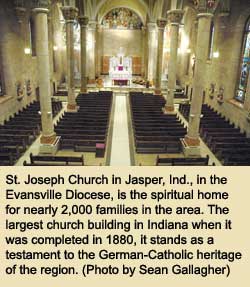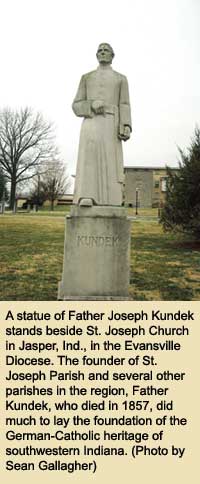Building on faith:
Southwestern Indiana’s German-Catholic heritage lives on
By Sean Gallagher
 ST. MEINRAD—When the Servant of God Simon Bruté, the first bishop of Vincennes, went to Jasper, Ind., to minister to the Catholics there, he struggled to communicate with the people and departed in tears.
ST. MEINRAD—When the Servant of God Simon Bruté, the first bishop of Vincennes, went to Jasper, Ind., to minister to the Catholics there, he struggled to communicate with the people and departed in tears.
The faithful there were primarily German immigrants. They did not understand French and the French-speaking bishop did not understand German.
Shortly before Bishop Bruté died in 1839, Father Joseph Kundek, a native German speaker born in present-day Croatia, came to minister to the German immigrants in the diocese.
Visitors to southwestern Indiana can still experience the rich German-Catholic heritage that Father Kundek nurtured during the two decades that he ministered there before his death in 1857.
That heritage is a living tradition today at Saint Meinrad Archabbey and School of Theology in St. Meinrad, and in the Evansville Diocese at Monastery Immaculate Conception in Ferdinand, Ind., and St. Joseph Parish in Jasper, Ind.
When St. Joseph Parish was founded in 1837, it was comprised of 26 households. But in the years to come, Father Kundek helped bring many more families of German immigrants to the area.
Today, the parish counts nearly 2,000 families on its rolls. They worship in a massive church built from 1867 to 1880. Its nave is 195 feet long and the pillars dotting the interior stand 67 feet high. The church’s bell tower is an impressive 235 feet tall.
At the time of its completion, St. Joseph Church was the largest church building in Indiana.
But the generations of Catholics in Jasper who succeeded those who built the church did not rest on their ancestors’ laurels.
Stained-glass windows were installed in 1898. Mosaics crafted in Innsbruck, Austria, were added in 1911. A terrazzo floor was laid in 1953. That same year, sandstone was used to line the interior walls—a complement to the church’s sandstone exterior. Finally, a new organ was built in 1995.
 St. Joseph Parish’s current pastor, Father Raymond Brenner, said that this ongoing concern for the state of the parish’s church is a sign of the deep faith of its members.
St. Joseph Parish’s current pastor, Father Raymond Brenner, said that this ongoing concern for the state of the parish’s church is a sign of the deep faith of its members.
“They’re strong about passing on their faith,” he said, “and making sure that it’s here for the next generation.”
Jasper’s German heritage also lives on in its annual Strassenfest, which is scheduled on Aug. 3-6 this year. German and American cuisine can be tasted at Jasper’s Schnitzelbank Restaurant year-round.
In 1854, Father Kundek convinced the abbot of Einseideln Abbey, a Benedictine monastery in Switzerland, to establish a foundation in southwestern Indiana with the idea that the German-speaking monks would minister to German immigrants in the area as well as train future priests for the Church in the region.
Saint Meinrad Archabbey and School of Theology stand today as the result of that venture started 152 years ago.
Just as the German-Catholic heritage of St. JosephParish in Jasper is a living tradition, the life of faith at Saint Meinrad is not a museum piece. It continues to live and breathe, offering visitors a place to revitalize their faith.
This happens especially at Saint Meinrad’s new Guest House and Retreat Center, which was dedicated last October and can accommodate more than 250 guests for frequent mid-week and weekend retreats.
Benedictine Father Vincent Tobin, the guest house manager, said he hopes that retreatants who come there gain “insight into their own spiritual relationship with God and therefore with people.”
Such insights can also be found in the pilgrimages that happen every Sunday afternoon during May and October to the Shrine of Our Lady of Monte Cassino across the Anderson River valley from the monastery.
Completed in 1858, the small hilltop shrine was the first sandstone structure built by the monks of Saint Meinrad.
According to Father Vincent, the particular Benedictine aspect to the German-Catholic heritage of the area helps the monks and visitors to the Archabbey apply their faith concretely to their everyday lives.
“It’s how to live the Christian life,” he said. “No monastery is founded with an absolute particular apostolate. You sink down roots where you are. And out of those roots come branches of all kinds of good things.”
The Benedictine hospitality shown to guests at Saint Meinrad Archabbey can be experienced more broadly by families at the nearby Holiday World and Splashin’ Safari theme park in Santa Claus.
And whereas the soul can be renewed through prayer at Saint Meinrad, the region also boasts beautiful natural attractions, such as the nearby Marengo Cave and Wyandotte Cave, which can revive the spirits of visitors.
Thirteen years after Saint Meinrad was founded, Benedictine sisters from Covington, Ky., who were rooted in their southern German Catholic heritage, arrived in nearby Ferdinand, Ind., to establish a foundation.
Monastery Immaculate Conception was the result. The monastery sits atop a large hill overlooking Ferdinand. Its huge church, which was built from 1915 to 1924 and recently restored, can be seen from miles away.
Like the monks of Saint Meinrad Archabbey, the Benedictine sisters at Monastery Immaculate Conception invite guests to come there to renew their life of faith at their Kordes Retreat Center.
But the heart of the life of Monastery Immaculate Conception is its church, where the sisters pray together several times a day.
“It’s the center,” said Benedictine Sister Kristine Kempf. “The church is the center of our life. Everything revolves around our prayer life. And so the church is the center.
“We wanted to restore the original beauty and keep the integrity of the space because it was done so beautifully and so artistically.”
(For more information about St. Joseph Parish in Jasper, log on to www.saintjosephjasper.com. For more information about Saint Meinrad Archabbey and School of Theology, log on to www.saintmeinrad.edu. For more information about Monastery Immaculate Conception in Ferdinand, log on to www.thedome.org.) †

